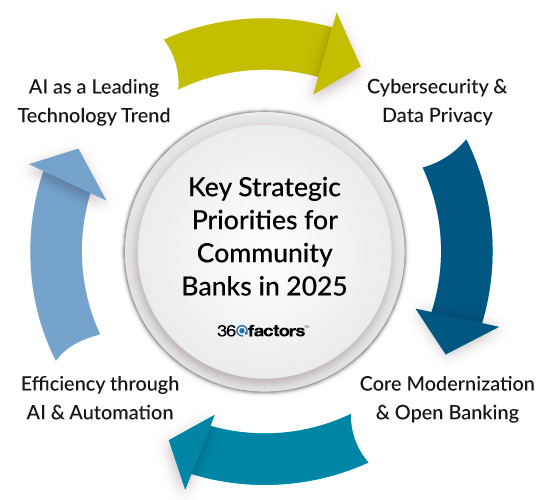Home/ Blog / How AI, Cybersecurity and Banking Modernization Are Transforming Community Banks in 2025
Community banks have long been considered trusted pillars in local economies, offering personalized financial services and fostering strong customer relationships. However, in 2025, these institutions are navigating a rapidly evolving landscape shaped by technological innovation, increasing cyber risks, and shifting regulatory demands. To remain competitive and resilient, improving community bank risk management strategies is necessary to address the emerging challenges.
According to the 2025 Banking Priorities Survey, key focus areas include Artificial Intelligence (AI), automation, and modernizing core banking systems. These priorities reflect a growing recognition that legacy systems and traditional processes are no longer sufficient in an environment where efficiency, speed, and security are paramount. Community banks are reevaluating their operations, leveraging AI to streamline compliance, automate repetitive tasks, and enhance customer experiences.
At the same time, the escalating risk of cyberattacks and increasing regulatory expectations are prompting community banks to develop more sophisticated risk management frameworks. As these pressures mount, banks must invest in AI-driven tools and enhanced cybersecurity measures to protect their customers and ensure regulatory alignment.
This blog examines the major trends and technologies shaping community banking in 2025, as well as how smarter, AI-based solutions are streamlining risk management in community banks.
Key Strategic Priorities for Community Banks in 2025
Small business banking is undergoing a strategic transformation to thrive in the rapidly evolving financial landscape of 2025. The survey reveals a strong focus on cybersecurity, modernization, operational efficiency, and the integration of AI. Let’s discuss this in detail:

Cybersecurity and Data Privacy in Banking
Cybersecurity and data privacy have emerged as the most significant risks facing community banks in 2025. As digital transactions become more prevalent, the potential for data breaches and cyberattacks increases, putting sensitive customer information and institutional reputations at risk. Notably, 28% of financial professionals identified cybersecurity and data privacy as the top concerns in the industry this year.
The financial impact of cyber incidents continues to rise. In 2024, the average cost of a data breach in the financial sector surged to $6.08 million, up from $5.9 million in 2023. This presents a serious financial and operational challenge for community banks operating with fewer resources than larger institutions.
Community banks ramp up their risk management defenses with AI-powered risk assessments, real-time fraud monitoring, and advanced cybersecurity tools. These technologies enable the proactive detection and mitigation of risks, helping institutions stay ahead of cybercriminals while ensuring compliance with increasingly stringent data privacy regulations.
The Shift to Core Modernization and Open Banking
Legacy systems are becoming obsolete as community banks prioritize modernizing their core banking systems. In 2025, 62% of small business banks are investing in core and ancillary products designed to support ongoing innovation and enhance operational efficiency. By moving away from outdated legacy applications, these banks are positioning themselves for improved scalability and streamlined operations.
A key component of modernization is the embrace of open banking. 57% of community banks are integrating open APIs to create a more connected financial ecosystem, enabling seamless collaboration with fintech providers and third-party services. Additionally, 53% of banks plan to evaluate technology based on its ability to support open banking initiatives.
The momentum behind open banking is accelerating, with total open banking transactions projected to reach $330 billion by 2027, a significant increase from $57 billion in 2023. As transactions increase, community banks’ risk management frameworks must be enhanced to ensure customer data is protected and partnerships remain secure.
Driving Efficiency with AI and Automation
Operational efficiency will be a top strategic priority for 44% of community banks in 2025. Banks are under increasing pressure to optimize their operations, enhance customer experience, and reduce costs, all while navigating growing regulatory complexities.
A significant driver of efficiency is the deployment of automation. Forty percent of community banks have identified deposit growth as one of their top three priorities. AI-powered insights can help them capture new accounts and tailor offerings to customers’ needs. Despite this focus on deposits, only 22% of community banks plan to prioritize loan growth, reflecting a shift in strategy (Source: The Financial Brand).
The financial benefits of automation are clear. 52% of banking executives report annual savings of at least $100,000 due to automation, with increased efficiencies frequently cited as a top organizational goal.
AI is the Leading Technology Trend in Banking
AI has firmly established itself as the driving force behind the transformation in community banking. As 33% of bankers identify AI as the most impactful technology trend of 2025, its role in fraud detection, AML compliance, and customer service has expanded rapidly. With 91% of banks relying on AI to bolster fraud and AML efforts and 90% integrating AI for enhanced customer service, it’s clear that AI is no longer a competitive advantage; it’s a necessity. Beyond banking, AI is expected to deliver a 21% net increase to the U.S. GDP by 2030, underscoring its broad economic potential.
While AI offers powerful capabilities, implementing and managing this technology can be daunting for community banks’ risk management policies, especially those with limited resources and smaller teams. To stay ahead, scalable, right-sized software for community banks can help them overcome unique challenges and meet budgetary constraints.
Enhancing Cybersecurity, AI Integration, and Banking Modernization with Predict360 Essentials
Community banks’ risk management frameworks must navigate rising cybersecurity risks, increasing regulatory demands, and the need for modernization. Having the right tools in place is critical. Predict360 Essentials is purpose-built for U.S. community banks, offering a scalable, AI-powered solution that simplifies risk and issue management without requiring additional headcount.
Predict360 Essentials empowers community banks to strengthen their risk management programs. It offers preconfigured risk assessments tailored to banking needs, covering BSA/AML, cybersecurity, UDAAP, fair lending, and other key areas. It streamlines the identification, assessment, and mitigation of risks. Additionally, community banks gain access to comprehensive risk libraries, including the Crowe Risk Library, which ensures standardized best practices in their risk management frameworks.
Request a Demo
Complete the form below and our business team will be in touch to schedule a product demo.
By clicking ‘SUBMIT’ you agree to our Privacy Policy.



